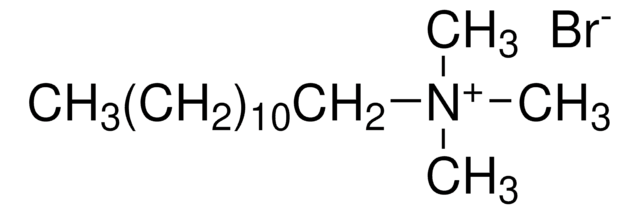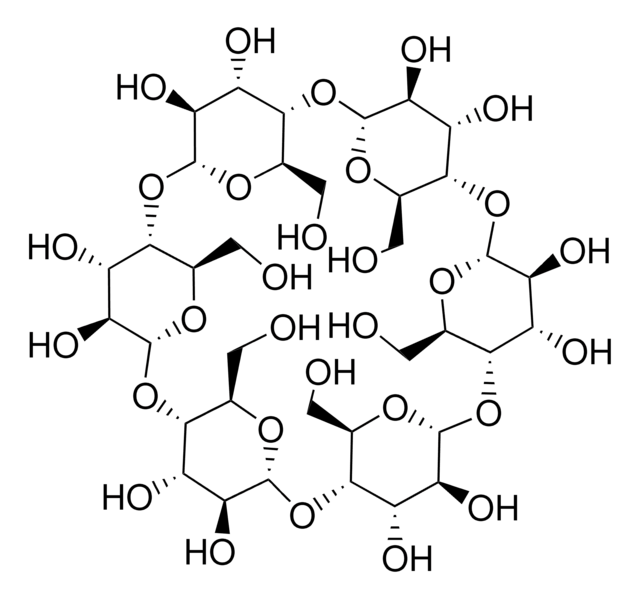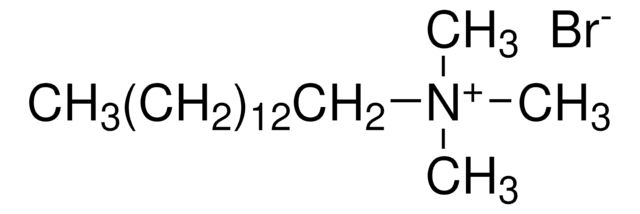Key Documents
D8638
Dodecyltrimethylammonium bromide
≥98%
Synonim(y):
Lauryltrimethylammonium bromide
About This Item
Polecane produkty
pochodzenie biologiczne
synthetic (oragnic)
Poziom jakości
opis
cationic
Próba
≥98%
Postać
powder
masa cząsteczkowa
308.34 g/mol
mp
246 °C (dec.) (lit.)
rozpuszczalność
954 g/L at 20 °C
gęstość
1.17 g/cm3 at 20 °C (68 °F)
ciąg SMILES
[Br-].CCCCCCCCCCCC[N+](C)(C)C
InChI
1S/C15H34N.BrH/c1-5-6-7-8-9-10-11-12-13-14-15-16(2,3)4;/h5-15H2,1-4H3;1H/q+1;/p-1
Klucz InChI
XJWSAJYUBXQQDR-UHFFFAOYSA-M
Szukasz podobnych produktów? Odwiedź Przewodnik dotyczący porównywania produktów
Opis ogólny
Beyond protein solubilization, this cationic detergent also finds application in DNA extraction procedures. Its ability to interact with DNA and alter its conformation facilitates the release of DNA from cellular components, enabling its subsequent purification and analysis. This property is particularly useful in the isolation of DNA from various biological samples, including tissues, cells, and microorganisms. Furthermore, DTAB demonstrates effectiveness in cell lysis processes. Its ability to disrupt cell membranes and release intracellular components makes it a valuable tool for breaking down cells and accessing their contents. This property has applications in various biological studies, including protein extraction, enzyme assays, and cellular component analysis.
Dodecyltrimethylammonium bromide (DTAB) stands as a versatile and widely applicable surfactant with a diverse range of applications in proteomics research, cell biology, and biochemical research. Its ability to solubilize proteins and peptides, extract DNA, and lyse cells makes it an essential tool for various biological studies and analytical techniques.
Zastosowanie
Cechy i korzyści
Inne uwagi
produkt podobny
Hasło ostrzegawcze
Danger
Zwroty wskazujące rodzaj zagrożenia
Zwroty wskazujące środki ostrożności
Klasyfikacja zagrożeń
Acute Tox. 3 Oral - Aquatic Acute 1 - Aquatic Chronic 1 - Eye Irrit. 2 - Skin Irrit. 2
Kod klasy składowania
6.1C - Combustible acute toxic Cat.3 / toxic compounds or compounds which causing chronic effects
Klasa zagrożenia wodnego (WGK)
WGK 3
Temperatura zapłonu (°F)
Not applicable
Temperatura zapłonu (°C)
Not applicable
Środki ochrony indywidualnej
dust mask type N95 (US), Eyeshields, Gloves
Certyfikaty analizy (CoA)
Poszukaj Certyfikaty analizy (CoA), wpisując numer partii/serii produktów. Numery serii i partii można znaleźć na etykiecie produktu po słowach „seria” lub „partia”.
Masz już ten produkt?
Dokumenty związane z niedawno zakupionymi produktami zostały zamieszczone w Bibliotece dokumentów.
Klienci oglądali również te produkty
Nasz zespół naukowców ma doświadczenie we wszystkich obszarach badań, w tym w naukach przyrodniczych, materiałoznawstwie, syntezie chemicznej, chromatografii, analityce i wielu innych dziedzinach.
Skontaktuj się z zespołem ds. pomocy technicznej













